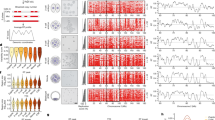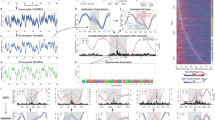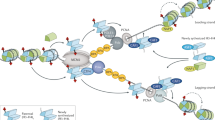Abstract
An overall link between the potential for gene transcription and the timing of replication in S phase is now well established in metazoans. Here we discuss emerging evidence that highlights the possibility that replication timing is causally linked with epigenetic reprogramming. In particular, we bring together conclusions from a range of studies to propose a model in which reprogramming factors determine the timing of replication and the implementation of reprogramming events requires passage through S phase. These considerations have implications for our understanding of development, evolution and diseases such as cancer.
This is a preview of subscription content, access via your institution
Access options
Subscribe to this journal
Receive 12 print issues and online access
$189.00 per year
only $15.75 per issue
Buy this article
- Purchase on Springer Link
- Instant access to full article PDF
Prices may be subject to local taxes which are calculated during checkout




Similar content being viewed by others
References
Aladjem, M. I. Replication in context: dynamic regulation of DNA replication patterns in metazoans. Nature Rev. Genet. 8, 588–600 (2007).
Collins, N. et al. An ACF1–ISWI chromatin-remodeling complex is required for DNA replication through heterochromatin. Nature Genet. 32, 627–632 (2002).
Groth, A., Rocha, W., Verreault, A. & Almouzni, G. Chromatin challenges during DNA replication and repair. Cell 128, 721–733 (2007).
Huvet, M. et al. Human gene organization driven by the coordination of replication and transcription. Genome Res. 17, 1278–1285 (2007).
Wintersberger, E. Why is there late replication? Chromosoma 109, 300–307 (2000).
Farkash-Amar, S. et al. Global organization of replication time zones of the mouse genome. Genome Res. 18, 1562–1570 (2008).
Hiratani, I. et al. Global reorganization of replication domains during embryonic stem cell differentiation. PLoS Biol. 6, e245 (2008).
McNairn, A. J. & Gilbert, D. M. Epigenomic replication: linking epigenetics to DNA replication. Bioessays 25, 647–656 (2003).
Cedar, H. & Bergman, Y. Choreography of Ig allelic exclusion. Curr. Opin. Immunol. 20, 308–317 (2008).
Horsthemke, B., Surani, A., James, T. & Ohlsson, R. The mechanisms of genomic imprinting. Results Probl. Cell Differ. 25, 91–118 (1999).
Pant, V. et al. The nucleotides responsible for the direct physical contact between the chromatin insulator protein CTCF and the H19 imprinting control region manifest parent of origin-specific long-distance insulation and methylation-free domains. Genes Dev. 17, 586–590 (2003).
Bergstrom, R., Whitehead, J., Kurukuti, S. & Ohlsson, R. CTCF regulates asynchronous replication of the imprinted H19/Igf2 domain. Cell Cycle 6, 450–454 (2007).
Tremblay, K. D., Duran, K. L. & Bartolomei, M. S. A 5′ 2-kilobase-pair region of the imprinted mouse H19 gene exhibits exclusive paternal methylation throughout development. Mol. Cell Biol. 17, 4322–4329 (1997).
Kanduri, C. et al. Functional association of CTCF with the insulator upstream of the H19 gene is parent of origin-specific and methylation-sensitive. Curr. Biol. 10, 853–856 (2000).
Dimitrova, D. S. & Gilbert, D. M. The spatial position and replication timing of chromosomal domains are both established in early G1 phase. Mol. Cell 4, 983–993 (1999).
Vogelauer, M., Rubbi, L., Lucas, I., Brewer, B. J. & Grunstein, M. Histone acetylation regulates the time of replication origin firing. Mol. Cell 10, 1223–1233 (2002).
Bell, S. P., Kobayashi, R. & Stillman, B. Yeast origin recognition complex functions in transcription silencing and DNA replication. Science 262, 1844–1849 (1993).
DePamphilis, M. L. et al. Regulating the licensing of DNA replication origins in metazoa. Curr. Opin. Cell Biol. 18, 231–239 (2006).
Sasaki, T. & Gilbert, D. M. The many faces of the origin recognition complex. Curr. Opin. Cell Biol. 19, 337–343 (2007).
DePamphilis, M. L. The 'ORC cycle': a novel pathway for regulating eukaryotic DNA replication. Gene 310, 1–15 (2003).
Cadoret, J. C. et al. Genome-wide studies highlight indirect links between human replication origins and gene regulation. Proc. Natl Acad. Sci. USA 105, 15837–15842 (2008).
Zellner, E., Herrmann, T., Schulz, C. & Grummt, F. Site-specific interaction of the murine pre-replicative complex with origin DNA: assembly and disassembly during cell cycle transit and differentiation. Nucleic Acids Res. 35, 6701–6713 (2007).
Tabancay, A. P. Jr & Forsburg, S. L. Eukaryotic DNA replication in a chromatin context. Curr. Top. Dev. Biol. 76, 129–184 (2006).
Danis, E. et al. Specification of a DNA replication origin by a transcription complex. Nature Cell Biol. 6, 721–730 (2004).
Kan, J. et al. ORC mediates histone 3 lysine 4 methylation through cooperation with SPP1 in Saccharomyces cerevisiae. J. Biol. Chem. 9 Oct 2008 (doi:10.1074/jbc.C800182200).
Miotto, B. & Struhl, K. HBO1 histone acetylase is a coactivator of the replication licensing factor Cdt1. Genes Dev. 22, 2633–2638 (2008).
Goren, A., Tabib, A., Hecht, M. & Cedar, H. DNA replication timing of the human β-globin domain is controlled by histone modification at the origin. Genes Dev. 22, 1319–1324 (2008).
Zhou, J. et al. Cell cycle regulation of chromatin at an origin of DNA replication. EMBO J. 24, 1406–1417 (2005).
Zhou, J., Chau, C., Deng, Z., Stedman, W. & Lieberman, P. M. Epigenetic control of replication origins. Cell Cycle 4, 889–892 (2005).
Perry, P. et al. A dynamic switch in the replication timing of key regulator genes in embryonic stem cells upon neural induction. Cell Cycle 3, 1645–1650 (2004).
Zhang, J., Xu, F., Hashimshony, T., Keshet, I. & Cedar, H. Establishment of transcriptional competence in early and late S phase. Nature 420, 198–202 (2002).
Zhang, Z., Shibahara, K. & Stillman, B. PCNA connects DNA replication to epigenetic inheritance in yeast. Nature 408, 221–225 (2000).
Moldovan, G. L., Pfander, B. & Jentsch, S. PCNA, the maestro of the replication fork. Cell 129, 665–679 (2007).
Rountree, M. R., Bachman, K. E. & Baylin, S. B. DNMT1 binds HDAC2 and a new co-repressor, DMAP1, to form a complex at replication foci. Nature Genet. 25, 269–277 (2000).
Esteve, P. O. et al. Direct interaction between DNMT1 and G9a coordinates DNA and histone methylation during replication. Genes Dev. 20, 3089–3103 (2006).
Wu, R., Terry, A. V., Singh, P. B. & Gilbert, D. M. Differential subnuclear localization and replication timing of histone H3 lysine 9 methylation states. Mol. Biol. Cell 16, 2872–2881 (2005).
Jorgensen, H. F. et al. The impact of chromatin modifiers on the timing of locus replication in mouse embryonic stem cells. Genome Biol. 8, R169 (2007).
Kupper, K. et al. Radial chromatin positioning is shaped by local gene density, not by gene expression. Chromosoma 116, 285–306 (2007).
Pombo, A. & Branco, M. R. Functional organisation of the genome during interphase. Curr. Opin. Genet. Dev. 17, 451–455 (2007).
Cremer, M. et al. Non-random radial higher-order chromatin arrangements in nuclei of diploid human cells. Chromosome Res. 9, 541–567 (2001).
Conti, C. et al. Replication fork velocities at adjacent replication origins are coordinately modified during DNA replication in human cells. Mol. Biol. Cell 18, 3059–3067 (2007).
Izumi, M., Yatagai, F. & Hanaoka, F. Localization of human Mcm10 is spatially and temporally regulated during the S phase. J. Biol. Chem. 279, 32569–32577 (2004).
Taddei, A., Hediger, F., Neumann, F. R. & Gasser, S. M. The function of nuclear architecture: a genetic approach. Annu. Rev. Genet. 38, 305–345 (2004).
Hancock, R. A new look at the nuclear matrix. Chromosoma 109, 219–225 (2000).
Courbet, S. et al. Replication fork movement sets chromatin loop size and origin choice in mammalian cells. Nature 455, 557–560 (2008).
Lemaitre, J. M., Danis, E., Pasero, P., Vassetzky, Y. & Mechali, M. Mitotic remodeling of the replicon and chromosome structure. Cell 123, 787–801 (2005).
Buongiorno-Nardelli, M., Micheli, G., Carri, M. T. & Marilley, M. A relationship between replicon size and supercoiled loop domains in the eukaryotic genome. Nature 298, 100–102 (1982).
Fisher, D. & Mechali, M. Vertebrate HoxB gene expression requires DNA replication. EMBO J. 22, 3737–3748 (2003).
Sproul, D., Gilbert, N. & Bickmore, W. A. The role of chromatin structure in regulating the expression of clustered genes. Nature Rev. Genet. 6, 775–781 (2005).
Johmura, Y., Osada, S., Nishizuka, M. & Imagawa, M. FAD24 acts in concert with histone acetyltransferase HBO1 to promote adipogenesis by controlling DNA replication. J. Biol. Chem. 283, 2265–2274 (2008).
Li, J., Santoro, R., Koberna, K. & Grummt, I. The chromatin remodeling complex NoRC controls replication timing of rRNA genes. EMBO J. 24, 120–127 (2005).
Pasero, P., Bensimon, A. & Schwob, E. Single-molecule analysis reveals clustering and epigenetic regulation of replication origins at the yeast rDNA locus. Genes Dev. 16, 2479–2484 (2002).
Petermann, E. et al. Chk1 requirement for high global rates of replication fork progression during normal vertebrate S phase. Mol. Cell Biol. 26, 3319–3326 (2006).
Shechter, D., Costanzo, V. & Gautier, J. ATR and ATM regulate the timing of DNA replication origin firing. Nature Cell Biol. 6, 648–655 (2004).
Siddiqui, K. & Stillman, B. ATP-dependent assembly of the human origin recognition complex. J. Biol. Chem. 282, 32370–32383 (2007).
Cuvier, O., Stanojcic, S., Lemaitre, J. M. & Mechali, M. A topoisomerase II-dependent mechanism for resetting replicons at the S–M-phase transition. Genes Dev. 22, 860–865 (2008).
Labit, H., Perewoska, I., Germe, T., Hyrien, O. & Marheineke, K. DNA replication timing is deterministic at the level of chromosomal domains but stochastic at the level of replicons in Xenopus egg extracts. Nucleic Acids Res. 36, 5623–5634 (2008).
Egli, D., Rosains, J., Birkhoff, G. & Eggan, K. Developmental reprogramming after chromosome transfer into mitotic mouse zygotes. Nature 447, 679–685 (2007).
Kloc, A., Zaratiegui, M., Nora, E. & Martienssen, R. RNA interference guides histone modification during the S phase of chromosomal replication. Curr. Biol. 18, 490–495 (2008).
Chen, E. S. et al. Cell cycle control of centromeric repeat transcription and heterochromatin assembly. Nature 451, 734–737 (2008).
Karnani, N., Taylor, C., Malhotra, A. & Dutta, A. Pan-S replication patterns and chromosomal domains defined by genome-tiling arrays of ENCODE genomic areas. Genome Res. 17, 865–876 (2007).
Gimelbrant, A., Hutchinson, J. N., Thompson, B. R. & Chess, A. Widespread monoallelic expression on human autosomes. Science 318, 1136–1140 (2007).
Kelly, B. L. & Locksley, R. M. Coordinate regulation of the IL-4, IL-13, and IL-5 cytokine cluster in Th2 clones revealed by allelic expression patterns. J. Immunol. 165, 2982–2986 (2000).
State, M. W. et al. Epigenetic abnormalities associated with a chromosome 18(q21–q22) inversion and a Gilles de la Tourette syndrome phenotype. Proc. Natl Acad. Sci. USA 100, 4684–4689 (2003).
D'Antoni, S. et al. Altered replication timing of the HIRA/Tuple1 locus in the DiGeorge and Velocardiofacial syndromes. Gene 333, 111–119 (2004).
Watanabe, Y., Shibata, K., Sugimura, H. & Maekawa, M. p53-dependent change in replication timing of the human genome. Biochem. Biophys. Res. Commun. 364, 289–293 (2007).
McGarvey, K. M. et al. Silenced tumor suppressor genes reactivated by DNA demethylation do not return to a fully euchromatic chromatin state. Cancer Res. 66, 3541–3549 (2006).
Watanabe, Y. et al. Chromosome-wide assessment of replication timing for human chromosomes 11q and 21q: disease-related genes in timing-switch regions. Hum. Mol. Genet. 11, 13–21 (2002).
Watanabe, Y., Ikemura, T. & Sugimura, H. Amplicons on human chromosome 11q are located in the early/late-switch regions of replication timing. Genomics 84, 796–805 (2004).
Sclafani, R. A. & Holzen, T. M. Cell cycle regulation of DNA replication. Annu. Rev. Genet. 41, 237–280 (2007).
Hasan, S., Hassa, P. O., Imhof, R. & Hottiger, M. O. Transcription coactivator p300 binds PCNA and may have a role in DNA repair synthesis. Nature 410, 387–391 (2001).
Jorgensen, S. et al. The histone methyltransferase SET8 is required for S-phase progression. J. Cell Biol. 179, 1337–1345 (2007).
Acknowledgements
We apologize that we are unable to discuss all observations relevant to the topics covered in this article owing to space limitations. We gratefully acknowledge D. Gilbert, A.P. Feinberg, D. Barlow, M. Debatisse and T. Helleday for valuable discussions. This work was supported by the Swedish Science Research Council, the Swedish Cancer Research Foundation, the Swedish Pediatric Cancer Foundation, the Lundberg Foundation and HEROIC and ChILL (EU integrated projects).
Author information
Authors and Affiliations
Related links
Glossary
- Asynchronous replication timing
-
The situation in which the two parental alleles replicate at different times during S phase.
- CpG island
-
Sequences of 200 bp or more that have a high GC content and a high frequency of CpG dinucleotides.
- Epigenetic reprogramming
-
The erasure and remodelling of epigenetic marks during mammalian development.
- Genomic imprinting
-
Monoallelic expression in a parent of origin-dependent manner.
- Heterochromatic block
-
A region in a chromosome that is tightly coiled and generally inactive in terms of gene expression.
- Pan-S replication
-
Sequences replicating throughout S phase in a cell population.
- Pre-replication complex
-
A protein complex that forms at the replication origin before initiation of DNA replication.
- Replication origin
-
A sequence at which replication is initiated.
- Replicon
-
A region of DNA that replicates from a single origin of replication.
Rights and permissions
About this article
Cite this article
Göndör, A., Ohlsson, R. Replication timing and epigenetic reprogramming of gene expression: a two-way relationship?. Nat Rev Genet 10, 269–276 (2009). https://doi.org/10.1038/nrg2555
Issue Date:
DOI: https://doi.org/10.1038/nrg2555
This article is cited by
-
Drosophila Rif1 is an essential gene and controls late developmental events by direct interaction with PP1-87B
Scientific Reports (2015)
-
3D hotspots of recurrent retroviral insertions reveal long-range interactions with cancer genes
Nature Communications (2015)
-
Mouse Rif1 is a key regulator of the replication-timing programme in mammalian cells
The EMBO Journal (2012)
-
Genome-wide analysis of the replication program in mammals
Chromosome Research (2010)
-
Chromosome crosstalk in three dimensions
Nature (2009)



